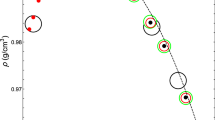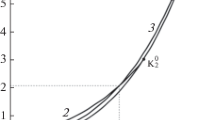Abstract
The representation of the Widom line as a line of maximums of the correlation length and a whole set of thermodynamic response functions above the critical point were introduced to describe anomalies observed in water above the hypothetical critical point of the liquid-liquid transition. The supercritical region for the gas-liquid transition was also described later in terms of the Widom line. It is natural to assume that an analogue of the Widom line also exists in the supercritical region for the first-order isostructural transition in crystals, which ends at a critical point. We use a simple semiphenomenological model, close in spirit the van der Waals theory, to study the properties of the new Widom line. We calculate the thermodynamic response functions above the critical point of the isostructural transition and find their maximums determining the Widom line position.
Similar content being viewed by others
References
R. Balesku, Equilibrium and Nonequilibrium Statistical Mechanics, Wiley, New York (1975).
J. P. Hansen and I. R. McDonald, Theory of Simple Liquids, Acad. Press, New York (1986).
V. V. Brazhkin and V. N. Ryzhov, “Van derWaals supercritical fluid: Exact formulas for special lines,” J. Chem. Phys., 135, 084503 (2011).
V. V. Brazhkin and V. N. Ryzhov, “Erratum: Van der Waals supercritical fluid: exact formulas for special lines,” J. Chem. Phys., 145, 059901 (2016).
A. Daanoun, C. F. Tejero, and M. Baus, “Van der Waals theory for solids,” Phys. Rev. E, 50, 2913–2924 (1994).
E. Kiran, P. G. Debenedetti, and C. J. Peters, eds., Supercritical Fluids: Fundamentals and Applications (NATO Sci. Ser. E, Vol. 366), Kluwer Academic, Dordrecht (2000).
V. V. Brazhkin, A. G. Lyapin, V. N. Ryzhov, K. Trachenko, Yu. D. Fomin, and E. N. Tsiok, “Where is the supercritical fluid on the phase diagram?” Phys. Usp., 55, 1061–1079 (2012).
H. Stanley, Introduction to Phase Transitions and Critical Phenomena, Clarendon, Oxford (1971).
L. Xu, P. Kumar, S. V. Buldyrev, S.-H. Chen, P. H. Poole, E. Sciortino, and H. E. Stanley, “Relation between the Widom line and the dynamic crossover in systems with a liquid–liquid phase transition,” Proc. Natl. Acad. Sci. USA, 102, 16558–16562 (2005).
P. H. Poole, S. R. Becker, F. Sciortino, and F. W. Starr, “Dynamical behavior near a liquid–liquid phase transition in simulations of supercooled water,” J. Phys. Chem. B, 115, 14176–14183 (2011).
G. Franzese and H. E. Stanley, “The Widom line of supercooled water,” J. Phys.: Condens. Matter, 19, 205126 (2007).
P. F. McMillan and E. H. Stanley, “Fluid phases: Going supercritical,” Nature Phys., 6, 479–480 (2010).
G. G. Simeoni, T. Bryk, F. A. Gorelli, M. Krisch, G. Ruocco, M. Santoro, and T. Scopigno, “The Widom line as the crossover between liquid-like and gas-like behaviour in supercritical fluids,” Nature Phys., 6, 503–507 (2010).
F. A. Gorelli, T. Bryk, M. Krisch, G. Ruocco, M. Santoro, and T. Scopigno, “Dynamics and thermodynamics beyond the critical point,” Sci. Rep., 3, 1203 (2013).
V. V. Brazhkin, Yu. D. Fomin, A. G. Lyapin, V. N. Ryzhov, and E. N. Tsiok, “Widom line for the liquid–gas transition in Lennard-Jones system,” J. Phys. Chem. B, 115, 14112–14115 (2011).
V. V. Brazhkin, Yu. D. Fomin, V. N. Ryzhov, E. E. Tareyeva, and E. N. Tziok, “True Widom line for a square-well system,” Phys. Rev. E, 89, 042136 (2014).
P. Gallo, D. Corradini, and M. Rovere, “Fragile to strong crossover at the Widom line in supercooled aqueous solutions of NaCl,” J. Chem. Phys., 139, 204503 (2013).
G. Ruppeiner, A. Sahay, T. Sarkar, and G. Sengupta, “Thermodynamic geometry, phase transitions, and the Widom line,” Phys. Rev. E, 86, 052103 (2012).
H.-O. May and P. Mausbach, “Riemannian geometry study of vapor–liquid phase equilibria and supercritical behavior of the Lennard-Jones fluid,” Phys. Rev. E, 85, 031201 (2012); Erratum, 86, 059905 (2012).
Yu. D. Fomin, V. N. Ryzhov, E. N. Tsiok, and V. V. Brazhkin, “Thermodynamic properties of supercritical carbon dioxide: Widom and Frenkel lines,” Phys. Rev. E, 91, 022111 (2015).
Y. D. Fomin, V. N. Ryzhov, E. N. Tsiok, V. V. Brazhkin, and K. Trachenko, “Dynamic transition in supercritical iron,” Sci. Rep., 4, 7194 (2014).
Yu. D. Fomin, V. N. Ryzhov, E. N. Tsiok, and V. V. Brazhkin, “Dynamical crossover line in supercritical water,” Sci. Rep., 5, 14234 (2015).
E. E. Tareyeva and V. N. Ryzhov, “Supercritical fluid of particles with a Yukawa potential: A new approximation for the direct correlation function and the Widom line,” Theor. Math. Phys., 189, 1806–1817 (2016).
H. Xia, A. L. Ruoff, and Y. K. Vohra, “Temperature dependence of the ω-bcc phase transition in zirconium metal,” Phys. Rev. B, 44, 10374–10376 (1991).
P. Bolhuis and D. Frenkel, “Prediction of an expanded-to-condensed transition in colloidal crystals,” Phys. Rev. Lett., 72, 2211–2214 (1994).
P. Bolhuis and D. Frenkel, “Isostructural solid-solid transition in crystalline systems with short-ranged interaction,” Phys. Rev. E, 50, 4880–4890 (1995).
D. Frenkel, “Colloidal encounters: A matter of attraction,” Science, 314, 768–769 (2006).
C. F. Tejero, A. Daanoun, H. N. W. Lekkerkerker, and M. Baus, “Phase diagrams of ‘simple’ fluids with extreme pair potentials,” Phys. Rev. Lett., 73, 752–755 (1994).
C. F. Tejero, A. Daanoun, H. N. W. Lekkerkerker, and M. Baus, “Isostructural solid-solid transition of (colloidal) simple fluids,” Phys. Rev. E, 51, 558–566 (1995).
C. Rascón, L. Mederos, and G. Navascués, “Solid-to-solid isostructural transition in the hard sphere/attractive Yukawa system,” J. Chem. Phys., 103, 9495 (1995).
C. Rascón, L. Mederos, G. Navascués, and L. Mederos, “Phase transitions in systems with extremely shortranged attractions: A density-functional theory,” Phys. Rev. B, 51, 14899–14906 (1995).
A. R. Denton and H. Löwen, “Isostructural solid–solid transitions in square–shoulder systems,” J. Phys.: Condens. Matter, 9, L1–L5 (1997).
Author information
Authors and Affiliations
Corresponding author
Additional information
This research was supported by a grant from the Russian Science Foundation (Project No. 14-22-00093).
__________
Translated from Teoreticheskaya i Matematicheskaya Fizika, Vol. 194, No. 1, pp. 175–184, January, 2018.
Rights and permissions
About this article
Cite this article
Tareyeva, E.E., Fomin, Y.D., Tsiok, E.N. et al. Supercritical Anomalies and the Widom Line for the Isostructural Phase Transition in Solids. Theor Math Phys 194, 148–156 (2018). https://doi.org/10.1134/S0040577918010117
Received:
Published:
Issue Date:
DOI: https://doi.org/10.1134/S0040577918010117




